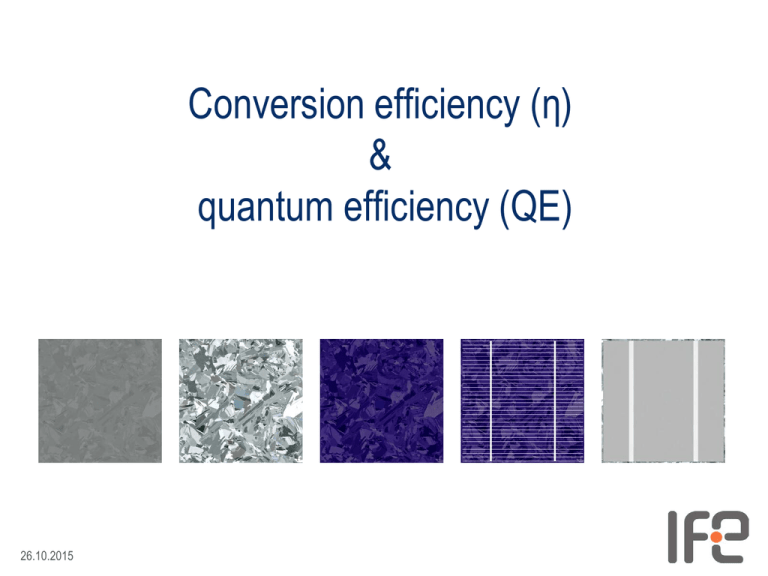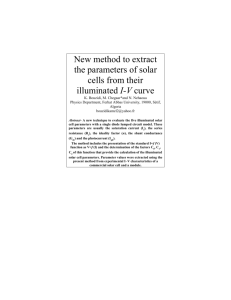Conversion efficiency (η) & quantum efficiency (QE) 26.10.2015
advertisement

Conversion efficiency (η) & quantum efficiency (QE) 26.10.2015 26.10.2015 26.10.2015 Overview • A standardized sun • Solar cell models • Conversion efficiency • Definitions • Limits • Measurements • Quantum efficiency measurements • Definitions • Limits • Measurements 26.10.2015 26.10.2015 A standardized sun • • The spectral distribution and the intensity of the Sunlight incident on a given location is determined by how much of the light is absorbed in the atmosphere. The absorption depends on two factors: • The local composition of the atmosphere. • The path length of the Sunlight through the atmosphere. • The effect of the atmospere is quantified using the parameter air mass (AM). AM = 26.10.2015 The actual path length of the sunlight through the atmosphere The thickness of the atmosphere Air mass • The path length of sunlight through the atmosphere is determined the angle θ between the sunlight and the normal of the horizon: AM = 1/cos(θ) • Example values: • θ = 0o • θ = 48o 26.10.2015 : AM1.0 : AM1.5 Air mass • • Solar cell characterization is performed using AM1.5 spectra normalized to 1 kW/m2. Commonly used solar spectra: • AM1.5: the industry standard for terrestrial solar cell applications. • AM0: a spectrum more relevant for space applications. • 26.10.2015 For theoretical calculations, the black body spectrum is sometimes used, since it allows for analytical solutions. A standardized sun: AM1.5 Visible light 1800 1600 1400 Irradiance 1200 1000 800 600 400 200 0 0 0,5 1 1,5 2 2,5 Wavelength [um] 26.10.2015 3 3,5 4 4,5 Solar cell operation Ephot = hc/λ > Eg - Eg + 26.10.2015 V Solar cells and power generation (The electrician’s point of view) • A solar cell is a two terminal device, which 1. Acts as a diode in the dark. 26.10.2015 Diode I-V characteristics Solar cells and power generation (The electrician’s point of view) • A solar cell is a two terminal device, which 1. Acts as a diode in the dark. 2. Generates photovoltage V and a photogenerated current ISC when illuminated. The photocurrent is determined by the irradiance 26.10.2015 Illuminated solar cell JSC Solar cells and power generation (The electrician’s point of view) • A solar cell is a two terminal device, which 1. Acts as a diode in the dark. 2. Generates photovoltage V and a photogenerated current ISC when illuminated. The photocurrent is determined by the irradiance • 26.10.2015 The total current-voltage (I-V) relationship of an illuminated solar cell is a superposition of the I-V characteristics of the diode and the photocurrent. Illuminated solar cell JSC Simple equivalent circuit diagram • A good model for simple evaluation of solar cell efficiency + JSC Jdark Vout - JTOT = Jdark – JSC = J0(eeV/kT – 1) – JSC 26.10.2015 Ideality factor • Real diodes rarely exhibit an ideal diode behaviour described by JTOT = J0(eeV/kT – 1) • A better description can be obtained by introducing an ideality factor (m) JTOT = J0(eeV/mkT – 1) 26.10.2015 Two-diode model • The most commonly used model in the solar cell research community and industry Rseries + JSC J0,1 J0,2 Rshunt Vout - JTOT = J0,1(eq(V+JARseries)/kT – 1) + J0,2(eq(V+JARseries)/2kT – 1) – JSC + (V + JARseries)/Rshunt 26.10.2015 Important solar cell parameters • • • • • 26.10.2015 Open circuit voltage Short circuit current Efficiency Fill factor Quantum efficiency VOC JSC η FF QE Open circuit voltage: VOC 26.10.2015 Short circuit current: ISC 26.10.2015 Conversion efficiency: η • The efficiency (η) of a solar cell is defined as the ratio between the output electrical power and the power of the light falling upon it in the following manner: η = Pcell / Psun • Pcell is given by Pcell = I·V 26.10.2015 Psun Pcell Conversion efficiency: η • η is defined at the maximum power point of the solar cell. η = Pmp/Psun = Imp·Vmp/Psun • η is sometimes called the conversion efficiency of a solar cell. 26.10.2015 FF • The fill factor (FF) is defined as the ratio FF = Im·Vm / ISC·VOC • η can be related to ISC and VOC through FF η = ISC·VOC ·FF / Psun 26.10.2015 FF • FF is determined by the shape of the I-V curve • • • • 26.10.2015 Ideality factor Series resistance Shunt resistance … Measuring η • η is extracted from I-V measurements of illuminated solar cells. • Solar cell characteristics depend on T and irradiance. • Solar cell efficiency must be measured under standard testing conditions (STC) for comparison. • Spectrum = AM1.5 • Irradiance = “1 Sun” = 1 kW / m2 UNLESS OTHERWISE SPECIFIED • Cell temperature (Tc) = 25 oC 26.10.2015 The solar simulator Light bulb 26.10.2015 Measuring η • I-V curves are fitted to a two-diode model • Several different algorithms for curve fitting • Speed is of the essence • In-line measurements of every cell and module • Heating an issue 26.10.2015 Measuring η • Controlled and calibrated measurements required • Effect of irradiance (G) JSC(G) ~ (JSC,ref/Gref) · G • Effect of temperature VOC(Tc) = VOC,ref + (Tc – Tc,ref) · (dVOC(T)/dT) 26.10.2015 Typical solar cell characteristics 40 SETTINGS: Cell Area: 156,25 cm2 Temperature: 25 oC Sun Intensity: 100 mW/cm2 30 20 CELL PARAMETERS: 10 0 -0,1 0,1 -10 -20 26.10.2015 0,3 0,5 0,7 Efficiency: Voc: Jsc: FF: Vmp: Jmp: J01: J02: Rs Rsh: 17,1 % 615 MV 36,4 mA/cm2 76,4 % 511 MV 33,5 mA/cm2 5,6∙10-10 mA/cm2 1,3 ∙10-4 mA/cm2 2,5 ∙10-3 Ω 26,2 Ω I-V signatures: shunt resistance 0 0,1 0,2 0,3 0,4 0,5 0 -0,5 -1 Current [A] -1,5 -2 -2,5 -3 0,1 0,5 1 -3,5 -4 -4,5 10 Rshunt -5 Voltage [V] 26.10.2015 0,6 0,7 0,8 I-V signatures: series resistance 0 0,1 0,2 0,3 0,4 0,5 0,6 0,7 0,8 0 -0,5 -1 1 Rseries Current [A] -1,5 -2 -2,5 0,1 -3 0,05 -3,5 0,01 -4 -4,5 -5 Voltage [V] 26.10.2015 What else is there? • Temperature-dependent I-V measurements • Temperature coefficient extraction • Time-dependent I-V measurements • Light-induced degradation • Indirect I-V measurements • • • • 26.10.2015 • Suns-Voc / «quasi-I-V curves» Concentrated I-V Spectrally dependent I-V Local I-V … Record efficiencies + uncertainties Solar cell Efficiency Theoretical limit for Si homojunction solar cell ~ 29.4 % Monocrystalline Si (Panasonic) 25,6 % ± 0,5 Multicrystalline Si (FhG-ISE) 20,4 % ± 0,5 Thin film transfer Si (Solexel, 43 um) 20,1 % ± 0,4 Large area mc-Si (Q-cells, LFC) 19,5 % ± 0,4 Large area sc-Si (Panasonic, HIT) 24,7% ± 0,5 Si solar panel Si (UNSW) 22,9 % ± 0,6 CIGS (NREL) 19,6 % ± 0,4 Si (Amonix, 92 Suns) 27,6 % ± 1,0 CdTe (GE Global Research) 19,6 % ± 0,4 Perovskite (EPFL) 14,1% ± 0,3 Si thin film (LG, nc-Si-based 3J) 13,4 %± 0,4 GaAs thin film (Alta devices) 28,8 % ± 0,9 GaInP/GaAs/Ge (Sharp, 1 Sun) 37,9 % ± 1,2 GaInP/GaAs/GaInNAs (Sharp, 302 Suns) 44,4 % ± 2,6 26.10.2015 Prog. Photovolt. Solar Cell Efficiency Tables 39 (2012) Quantum efficiency • ”Particles out per particles in” • A diagnostic tool • Very important for determining loss mechanisms in real solar cells 26.10.2015 Photogenerated current • The photocurrent depends on several factors • The incident irradiation (bs(E)) • The amount of reflected light from the solar cell • Reflectance (R(E)) • The amount of light absorbed within the solar cell • Absorbance (a(E)) • The probability of collecting photogenerated charge carriers at an external terminal • Collection efficiency (ηcoll(E)) • The area (A) of the solar cell 26.10.2015 bs(E) R(E) a(E), ηcoll(E) Photogenerated current bs(E) R(E) a(E), ηcoll(E) ISC(E) = q · A · ([1 – R(E)] · ηcoll(E) · a(E) · bs(E)) 26.10.2015 QE • • The quantum efficiency (QE(E)) is a measure of the probability of an incident photon generating one electron that is successfully collected at the terminals The external quantum efficiency (EQE(E)) is given by EQE(E) = [1 – R(E)] · ηcoll(E) · a(E) ISC(E) = q · A · EQE(E) · bs(E) • The internal quantum efficiency (IQE(E)) neglects reflective losses, and is given by IQE(E) = ηcoll(E) · a(E) ISC(E) = q · A · [1 – R(E)] IQE(E) · bs(E) 26.10.2015 Measuring IQE and EQE Lamp PC Monochromator Chopper Reference diode Integrating sphere Mirror Solar cell 26.10.2015 EQE and IQE Rear surface and bulk recombination, transmission IQE/EQE [%] Front surface and emitter recombination Optical losses Band gap energy Wavelength [λ] 26.10.2015 Wikipedia 26.10.2015 Example: lifetime (PC1D) 100 90 80 IQE [%] 70 60 50 40 30 20 IQE 1 IQE 100 IQE 10000 IQE 10 10 0 300 400 500 600 700 800 900 1000 1100 1200 Wavelength [nm] Marstein (2012) 26.10.2015 Predicting solar cell efficiency (PL) 26.10.2015 342 351 (15.3%) (16.5%) Predicting solar cell efficiency (EL) 26.10.2015 342 351 (15.3%) (16.5%) Tandem King et al.APL 90 183516 (2007) 26.10.2015 IQE/EQE [%] Up- and down conversion (UC/DC) DC Band gap energy Wavelength [λ] 26.10.2015 UC




